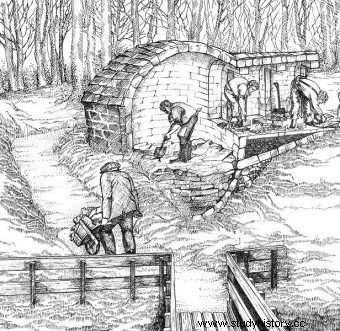Today it is difficult to imagine a kitchen without a refrigerator. In homes, shops, gas stations, even kiosks, there are refrigerators everywhere to store perishable food and cool drinks. How was this problem dealt with in the 19th century?
Every self-respecting housewife always has a small supply of everything, sufficient "just in case". Of course, since all supermarkets, discounters and shops have proliferated in Poland, this stock can be quickly enlarged or modified if necessary. Well, in the 19th century it was not that easy, so the resourceful mistress of the house had to prepare properly for each season of the year. And I'm not talking about replacing your wardrobe with a more fashionable one…
How was it frozen when there were no freezers?
Popular guides came to the rescue, which were basically the bible for the then landowners. It was from them that the ladies learned how to prepare preserves, store grapes for the winter, and how to remove stains. The authors of the guides also gave the readers practical tips on how to better arrange the farm.

The construction of the ice house was not an undertaking for one person. But what did your heiress make of farm peasants?
Among the many tips, a prominent place was a recipe for the then version of our good refrigerator - the ice shop . What was behind this mysterious name? It's safe to say it's winter in a box. It was a special room (and often a separate building) in which, thanks to various clever measures, it was possible to keep the temperature close to zero even in the hottest heat.
The ice house performed various functions in the manor, not only the most obvious ones. Karolina Nakwaska, the author of the book "Manor House, a work devoted to Polish housewives, useful and to people living in the city" (1843), apart from her practical role, found almost deadly advantages:
... sometimes it does not contribute little to health either, because there are many diseases in which the life of a sick person can only be saved with the help of God and ice (...) so put it aside ice shop for the amount you need, and you will be rewarded very quickly (quote from M. and J. Łoziński, "The History of Polish Taste").
At a time when medicine was still in its infancy, having access to a decent cool compress for high fever was undoubtedly a matter of life and death. However, in addition to such serious-sounding applications, the icehouse also had the more prosaic ones - it was used to store perishable food at a time when the refrigerators we know were just pipe dreams in the minds of crazy inventors.
Do it yourself:own ice cream room
Although it was quite an expense, an ice house was undeniably needed in every court. Therefore, resourceful housewives, if they did not inherit it from their ancestors, reached for the advice of proven authors and managed the construction according to them.

The title page of Nakwicka's guide.
The best place for such a sanctuary was a low mound, shaded by the spreading canopy of old trees, which were abundant in court parks. In this mound, a hole was dug, the walls of which were bricked up or built of wood.
As for the latter method, it required the construction of double walls, between which a heat-impermeable material, such as straw, was inserted. At the bottom of the ice house, a metal grate was placed on which the ice rested. As it gradually melted over the following months, the water trickled down below the grate and soaked into the ground. Instead of the usual roof, the ice shop had a vault insulated with earth, turf and moss.
However, the use of these methods gave only half the success - after all, there was only an entrance. Here, the invaluable suggestions of the authors of the guides came to the rescue. The above-mentioned Nakwaska recommended:
there should be a small corridor, narrow, half-timbered, with two sealed doors. The first from the manor to the north, they are to open to the left; the second one, from the icehouse itself, to the right. It is also good when the corridor does not go straight from the manor house to the ice room, but in a semicircle, like the surface of the ice room, so that the air and light can get as little as possible. A person who enters behind him should close the first door before opening the second one, for this reason, with a lantern in his hand, and only in the evening or before sunrise, one should enter. (Quote from M. and J. Łoziński, "The History of Polish Taste")
Now that you know how to prepare the ice shop and how to enter it, it's time for a practical instruction on how to refill the "coolant".
How do I get the ice into the ice room?
When, at the turn of the year, nature rested peacefully under a thick layer of snow, and the whole world was gripped by severe frost, it was possible to start filling the iceberg. The latter required the involvement of more people.
Large chunks of ice were brought from rivers and lakes, previously cut with saws from the frozen sheet and pulled out with hooks. These lumps were smashed inside it and - attention - poured with hot water. Using boiling water in a place intended to keep the temperature as low as possible seems absolutely absurd, but there was a method to this madness! The poured ice fragments changed from place to place into a solid lump, which later melted much more slowly. A thick layer of salt was poured over all of this (Nakwaska mentions a few pots, but points out that the more the better).
Once all the planning and construction work was done and the ice was taken away, it was possible to start using this complicated refrigerator. It contained meat, venison, dairy products (the old Polish belief that butter, which turned green and its consistency to an undefined consistency, had the best, tastiest aromas long abandoned) and various other perishable food items. As a result, even in the summer months, there was no greater risk of food poisoning caused by eating spoiled food.
In addition to this function, the ice shop performed one more, extremely important. On the hottest heat, when even the most elegant ladies could do nothing against the heat pouring down from the sky and the sweat spraying the pale faces, the icehouse was also the salvation. Already in the nineteenth century, heiresses could not imagine summer without cold drinks and, of course, ice cream! It was only thanks to the ice shops that the chefs could turn the fluffy and aromatic slush into ice cream, and lower the temperature of the unbearably warm drink accordingly.
When it's December outside the window, and the thermometer is frost, it is easy to underestimate the role of a refrigerator in every kitchen ... But just imagine that during the greatest summer heat, someone will turn it off, or it will break down at the least expected moment (which we do not wish anyone), and a slight appears fear. Great-great-grandmothers were not afraid of similar failures. And on top of that, their refrigerators were completely ecological!
Sources:
- Maja and Jan Łoziński, History of Polish taste , PWN, Warsaw 2012.
